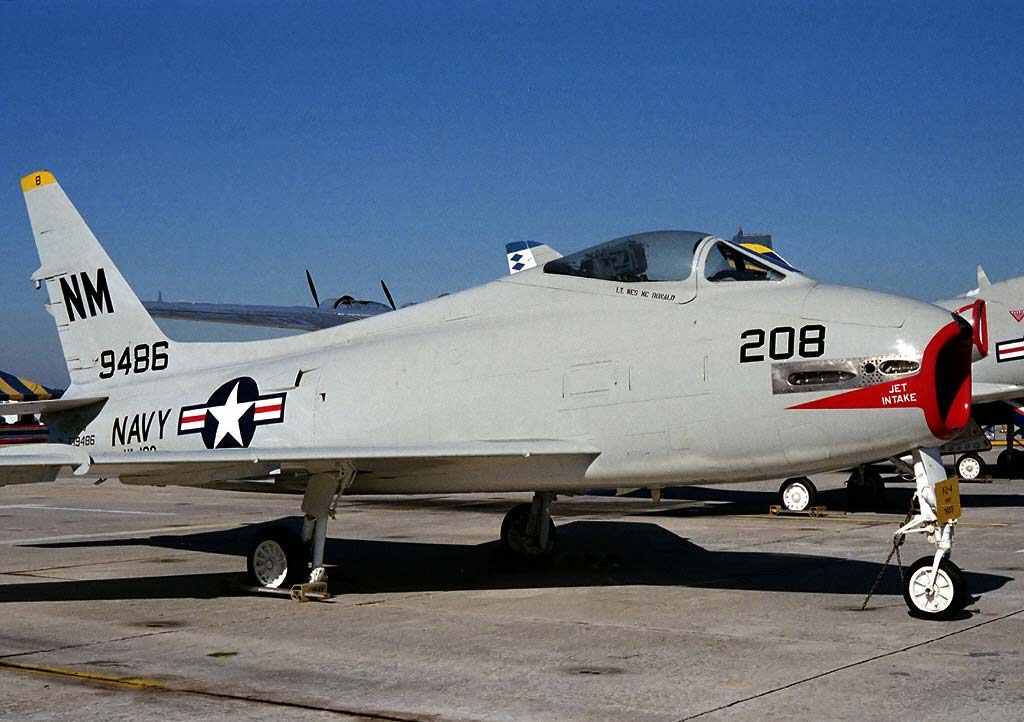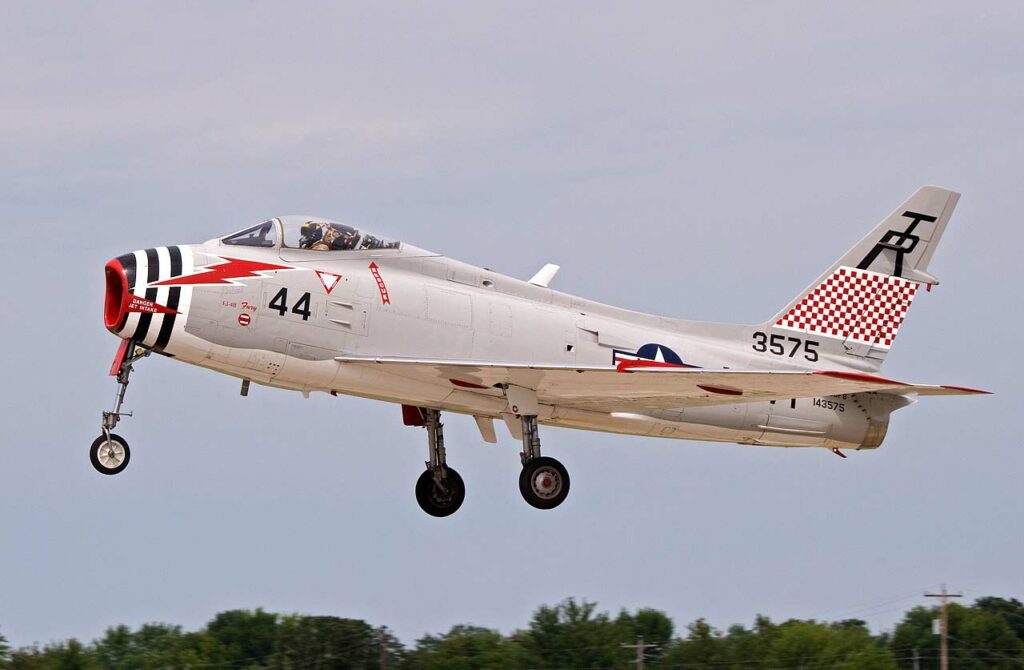The North American FJ-4 Fury is a single-seat carrier-based fighter-bomber, developed in the 1950s with a Wright J65-W-16A turbojet, offering a maximum speed of 680 mph.
In brief
The North American FJ-4 Fury was a carrier-based fighter-bomber developed by North American Aviation for the United States Navy and Marine Corps during the 1950s. As an evolution of the earlier FJ-3, the FJ-4 featured significant improvements including a thinner swept wing and increased fuel capacity. It was powered by a Wright J65-W-16A turbojet engine, achieving a maximum speed of 680 mph and a service ceiling of 46,800 feet. The aircraft was armed with four 20mm cannons and could carry a variety of ordnance including rockets and missiles. The FJ-4B variant was specifically designed for ground attack, featuring additional underwing hardpoints. A total of 374 FJ-4 Furies were built, serving primarily in air-to-air combat, ground attack, and close-air support roles.
The North American FJ-4 Fury was an important carrier-based fighter-bomber during the Cold War, serving with the United States Navy and Marine Corps.

History of Development
In the context of the Cold War and the rapid development of military aviation technology, the United States Navy needed an advanced fighter-bomber capable of operating from aircraft carriers. The FJ-4 Fury was developed by North American Aviation to fulfill this requirement, evolving from the earlier FJ-3 Fury, which itself was a naval adaptation of the renowned F-86 Sabre.
The FJ-4 was designed to address the limitations of its predecessors, with a focus on improving range, payload capacity, and overall performance. The development program aimed to create an aircraft that could effectively conduct both air-to-air combat and ground attack missions, reflecting the diverse operational needs of the Navy and Marine Corps during this period.
The first FJ-4 Fury took to the skies on October 28, 1954, marking a significant advancement in carrier-based aviation. North American Aviation, the manufacturer of the famous P-51 Mustang and F-86 Sabre, brought its extensive experience in fighter design to the Fury project.
The FJ-4 did not have a specific NATO nickname, as it was primarily used by U.S. forces and did not have the same international presence as some contemporaneous aircraft.
The FJ-4 Fury’s introduction into service was timely, as it provided the Navy and Marine Corps with a versatile and capable aircraft that could meet the demands of the evolving Cold War battlefield. Its development was a response to the need for a high-performance, carrier-capable aircraft that could effectively counter potential threats from the Soviet Union and its allies.
Design
The North American FJ-4 Fury was a single-seat, carrier-based fighter-bomber, representing the culmination of the Fury series. It was 36 feet 4 inches (11.1 meters) long, with a wingspan of 39 feet 1 inch (11.9 meters) and a height of 13 feet 11 inches (4.2 meters). The aircraft had an empty weight of 13,210 pounds (6,000 kilograms) and a maximum takeoff weight of 23,700 pounds (10,750 kilograms).
One of the key design changes in the FJ-4 was the introduction of thinner swept wings with a 6 percent thickness-to-chord ratio and an increased wing area of 338.66 square feet (31.46 square meters). These design enhancements improved the Fury’s low-speed handling and overall aerodynamic efficiency.
The aircraft’s landing gear was significantly modified to better fit within the wing’s outline, contributing to a more streamlined design. The main wheel track was widened, and the placement of the wheels closer to the center of gravity resulted in reduced nosewheel weight, enhancing stability and handling on carrier decks.
The FJ-4 Fury was powered by a Wright J65-W-16A turbojet engine, providing 7,700 pounds-force (34 kN) of thrust. This engine was an axial-flow turbojet with a 13-stage axial compressor, annular combustors, and a two-stage axial turbine. The Fury’s powerplant was crucial in delivering the high-speed performance required for both air-to-air combat and ground attack missions.
The design of the Fury also focused on increasing fuel capacity, with the FJ-4 carrying 50 percent more fuel compared to the FJ-3. This increase significantly extended the aircraft’s range and endurance, crucial for operations from aircraft carriers.
The FJ-4’s armament included four 20mm Colt Mk 12 cannons, providing formidable firepower for air-to-air engagements. The aircraft was also capable of carrying a range of underwing ordnance, including rockets, missiles, and bombs, making it versatile for various combat scenarios.
Overall, the design of the FJ-4 Fury represented a balance between the requirements of carrier-based operations, high-speed performance, and multi-role capabilities. The aircraft’s improvements over its predecessors made it a valuable asset for the U.S. Navy and Marine Corps during its service life.
Performance
The North American FJ-4 Fury’s performance was characterized by its impressive speed, range, and payload capacity, making it a formidable aircraft in both air-to-air combat and ground attack roles. The Fury’s maximum speed was 680 mph (1,094 km/h) at sea level, a significant achievement for a carrier-based aircraft of its time. Its range was extended to 2,020 miles (3,250 km) with the addition of two 200-gallon (760-liter) drop tanks and two AIM-9 Sidewinder missiles.
The aircraft had a service ceiling of 46,800 feet (14,300 meters), allowing it to operate at high altitudes, essential for intercepting enemy aircraft and conducting reconnaissance missions. The Fury’s rate of climb was an impressive 7,660 feet per minute (38.9 m/s), demonstrating its ability to quickly reach operational altitudes.
In terms of armament, the FJ-4 was equipped with four 20mm Colt Mk 12 cannons, providing significant firepower for air-to-air engagements. The aircraft could also be outfitted with six LAU-3/A 70mm rocket pods, four AIM-9 Sidewinder short-range air-to-air missiles, or other configurations of rocket pods. Additionally, the FJ-4 was capable of carrying 3,000 pounds (1,400 kg) of underwing ordnance, including missiles and bombs, enhancing its ground attack capabilities.
When compared to contemporaneous aircraft such as the McDonnell F3H Demon and the Republic F-84F Thunderstreak, the FJ-4 Fury held its own in terms of speed and versatility. Its ability to operate from aircraft carriers added a significant strategic advantage, allowing the U.S. Navy to project power far from its shores.
The Fury’s performance, particularly in the realm of speed and payload capacity, made it a powerful tool in the U.S. military’s arsenal during the Cold War. Its versatility in both air-to-air and ground attack roles exemplified the multi-role fighter concept that would become increasingly important in later generations of combat aircraft.
Variants
The North American FJ-4 Fury had several variants, each tailored for specific operational roles:
FJ-4 Fury: The base series designation, featuring the improved design and performance characteristics over previous Fury models.
FJ-4B: A dedicated ground attack model with reinforced undercarriages and six underwing hardpoints for carrying a broader range of munitions. This variant was capable of carrying up to 3,000 pounds of ordnance, including conventional bombs, rockets, and AIM-9 Sidewinder missiles. The FJ-4B also had the capability to deliver a nuclear bomb, a common requirement for Cold War aircraft.
FJ-4F: A limited conversion of the FJ-4 to a hybrid propulsion design, featuring an additional American Rocketdyne AR-1 rocket engine for an extra 5,000 pounds of thrust. This variant was intended for quick-reaction interception roles but was limited to only two conversions.
F-1E and AF-1E: Following the introduction of a new aircraft designation system, the FJ-4 and FJ-4B models were redesignated as F-1E and AF-1E, respectively.
These variants of the FJ-4 Fury exemplified the aircraft’s adaptability to different combat roles, from standard air-to-air missions to specialized ground attack and quick-reaction interception scenarios.

Military Use and Combat
The North American FJ-4 Fury was primarily utilized by the United States Navy and Marine Corps for a range of missions including air-to-air combat, ground attack, and close-air support. The Fury’s standard armament of four 20mm internal automatic cannons made it effective in air-to-air engagements. Additionally, it could carry up to 3,000 pounds of underwing stores, including conventional drop ordnance and AIM-9 Sidewinder missiles, enhancing its versatility in combat scenarios.
The FJ-4 Fury did not see extensive combat use; however, its presence as a carrier-based fighter-bomber added significant value to U.S. naval aviation capabilities during the Cold War. Its ability to deliver a diverse array of ordnance, coupled with its high speed and maneuverability, made it well-suited for supporting ground troops and engaging enemy aircraft.
One notable aspect of the FJ-4 was its capability to carry a nuclear bomb, a critical requirement for many Cold War-era military aircraft. This capability underscored the strategic importance of the Fury in the context of nuclear deterrence and the broader Cold War military strategy.
The FJ-4 Fury competed with several other contemporary aircraft, such as the Mikoyan-Gurevich MiG-17 and the Dassault Mystère IV. While these aircraft had their own strengths, the Fury’s combination of speed, payload capacity, and carrier-based operations provided a unique and valuable set of capabilities to the U.S. Navy and Marine Corps.
The FJ-4 Fury was not exported beyond U.S. military use, and its service life was relatively short compared to some other fighter aircraft of the era. The last FJ-4 Fury was retired during the 1960s, with a total of 374 units built. Its retirement marked the end of the Fury line, which had started with the straight-winged FJ-1 and evolved through several iterations to the final FJ-4 model.
The North American FJ-4 Fury was a significant aircraft in the history of U.S. naval aviation, representing the culmination of the Fury series and showcasing the advancements in carrier-based fighter-bomber design during the 1950s. Although its service life was relatively short, the Fury’s performance and versatility in both air-to-air combat and ground attack roles made it a valuable asset to the United States Navy and Marine Corps. The FJ-4 Fury’s legacy lives on as a testament to the rapid evolution of military aviation technology during the Cold War era.
Back to the Fighter Jet section.